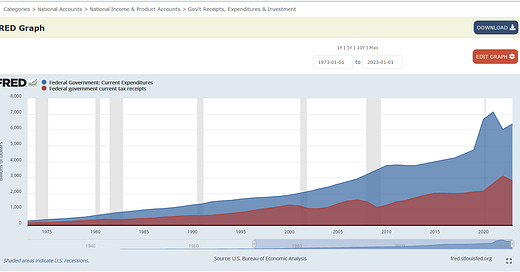Early on, the United States of America inspired the world with what is possible for a society that was, for the most part, a free society. It was as if we were not just the United States of America, but the United States of Freedom. Millions dreamed to come to our shores in order to escape autocratic rule and live the American Dream.
Over time, little encroachments against freedom turned into big encroachments, resulting in a lopsided power structure not too different from the autocratic rule which humanity has always faced throughout all of recorded history. Today, U.S. citizens suffer under inflation from money-printing and even domestic surveillance.
The Founding Fathers would be ashamed to see what has become of governance in the USA. Ideally, a government would spend up to the limit of the tax revenue it takes in, but not any more than that. Currently, we suffer from a government that spends (blue) more than twice the tax revenue that it takes in (red):
By taking in less than 3 trillion in tax revenue, but spending over 6 trillion, the annual deficit for 2023 — based solely on tax revenue — is about $3.5 trillion. The only reason that the official annual deficit number isn’t that high is because the U.S. government has encroached into the markets and collects revenue which should have been private.
But having the government act like a private citizen — and collect revenue by means other than taxation, like everyone else does — only worsens the problem, because government interference in free market mechanisms perturbs the system of free enterprise, which increases costs while lowering revenues (government erodes profits).
Because people face higher costs and obtain less income, our debt levels rise. Back in 1955, households and businesses each had total debt that was worth 30% of GDP:
But by 2024, things had grown more than 100% worse for U.S. households and U.S. businesses:
The debt held by households more than doubled as a share of GDP. The debt held by businesses also more than doubled as a share of GDP. The debt held by the federal government also almost doubled as a share of GDP. This debt acts like a weight on any attempted future climb up the ladder of success.
If you want to see what happens to debt when you disturb freedom for several decades in a row, look at China, where two-thirds of all corporations are state-owned:
With corporate debt that is 133% of GDP, prospects for a bright future in China are dim. That was to be expected though. For 104 years since Mises wrote Economic Calculation in the Socialist Commonwealth, it has been known that autocratic systems are not sustainable — and that places like China will be doomed in the long-run.
But, instead of learning from their mistakes, current U.S. governance almost seems to be falling over itself trying to emulate China — with a corrupt merger of state and corporate entities, and even plans to develop a social credit system and a central bank digital currency which would virtually enslave the critics of government bureaucrats.
Let’s not follow autocratic examples in the world but, instead, let’s return ourselves to the freedom of the past. Let’s reject any calls for a Great Reset. We don’t need “new fascism” or “new communism” or “new socialism” or “new technocracy” — we only need plain ole’ American freedom again, like we used to have.








Great report! Thank you. Interesting to compare commie Canada under our totalitarian Turdeau government and the US.
Central Government Debt per Capita (Current LCU): Canada: 26,811.82 (Ranked 28th), USA: 39,342.95 (Ranked 20th)
The USA has a significantly higher central government debt per capita compared to Canada, with a difference of 12,531.13 (47% more).
External Debt per Capita (Current LCU): Canada: $22,719.28 (Ranked 20th), USA: $40,678.76 (Ranked 12th)
The USA has a higher external debt per capita compared to Canada, with a difference of 17,959.48 (79% more).
Government Debt (Gross Government Debt, Share of GDP): Canada: 85.64% (IMF Ranked 20th), USA: 106.53% (IMF Ranked 11th)
The USA has a higher gross government debt as a percentage of GDP compared to Canada, with a difference of 20.89 percentage points (24% more).
Additional Insights:
Canada’s consolidated general government debt (federal, provincial, territorial, and local governments combined) stood at $2,942 billion (or $76,135 per capita) as of 2021.
The USA’s national debt per capita in 2023 was approximately $92,528.